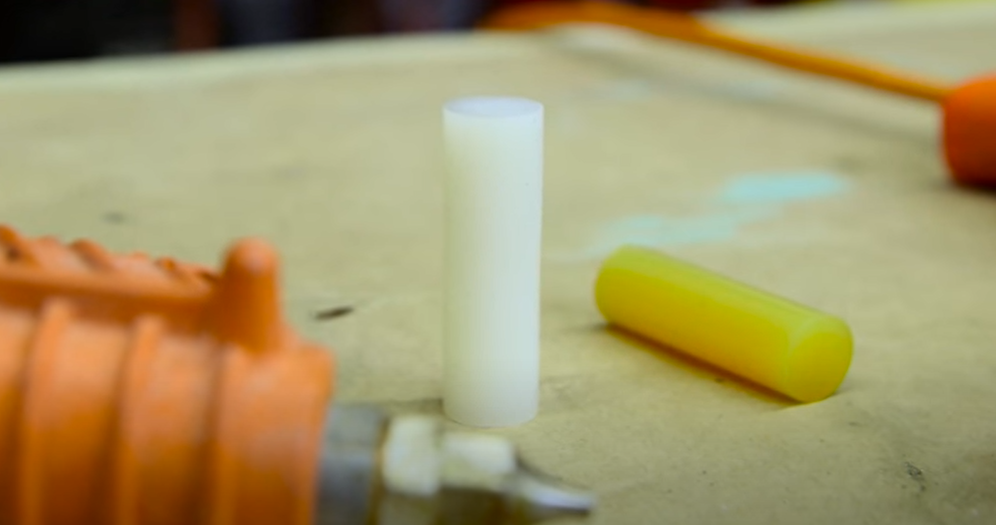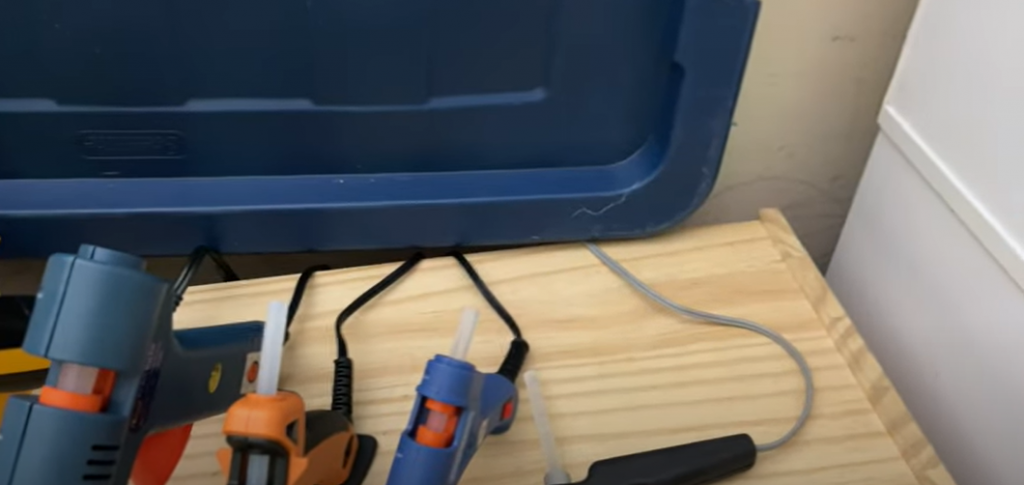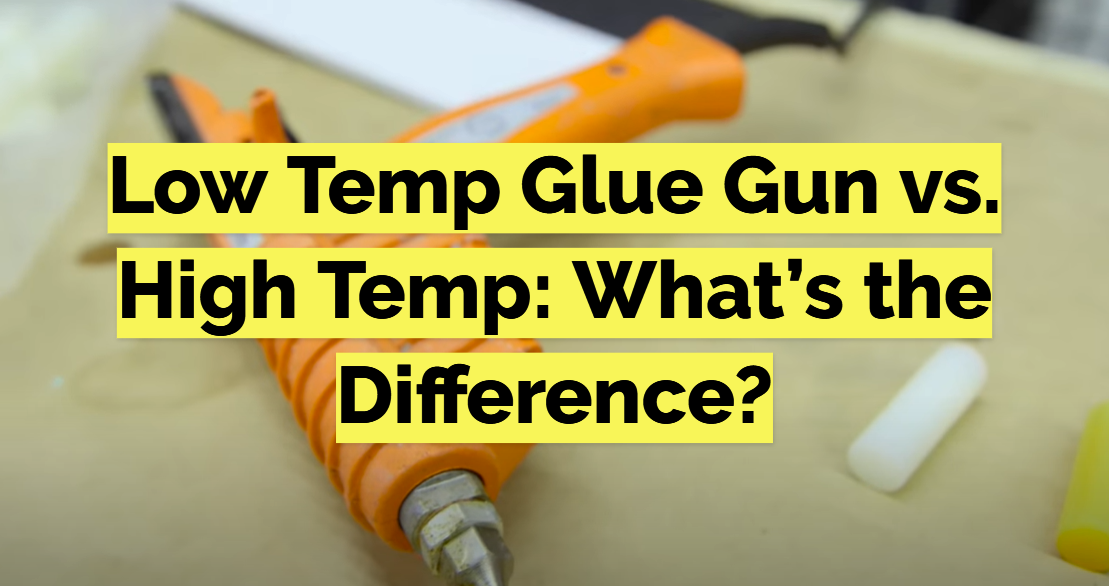So you’re looking for a glue gun? There are two main types to choose from, low temperature and high-temperature models. If your project requires different temperatures of adhesive then this article will help guide your decision as we discuss key features about each type along with reviews on some great products that can be used in any situation! We’ll also provide helpful tips when picking out just what kind would work best based on preferences like desired application or budget constraints.
Table of Contents
Low Temp Glue Gun
Glue guns come in different temperatures, with the low-temperature models being ideal for crafting or repairing delicate items. They also make a safe and temporary bond that can last longer than high temp glue sticks because they don’t melt as easily when applied to surfaces like woodwork where there’s no need of sticking anything firm into place – unless you’re looking at making an ironing board cover perhaps? One downside is taking longer heating time up before use; but this just means your project gets warmer faster.
The best low temp glue guns on the market are here in our opinion. One of them, easily Adtech Mini LoTemp Glue Gun, can be used by anyone and it comes with two sticks so you’ll never run out! It also has a fast warm up time – only six minutes which makes this model one of the most affordable options available but still offers some great features like an easy grip or stand-alone function for when working alone. [1]

Why select a low melt glue gun?
Low-melt glue guns are ideal for a variety of applications where precision and control is needed. They offer very little fumes, have shorter drying times than traditional hot glues due to their lower heat sensitivity (making them safer), plus they can be used in situations where you don’t want the danger or messes associated with high pressured air reloading systems like those found on many large professional machines!
A big bonus? You get all these benefits without sacrificing anything – including time wasted waiting around while things cool down after being fired up again because there isn’t any soupy gooey left behind from uselessly burnt material either way.
High Temp Glue Gun
The high temperature glue gun is an excellent choice for bonding materials that require stronger bonds. The maximum boiling point of 400 degrees Fahrenheit means these guns can reach all the way up to metal and glass, while also being able to set quickly so you’ll have time to limit your project without running out of hot tacky goodness! It’s worth spending just a little more money on this type because what would be otherwise impossible with low-temperature glue sticks may now become possible due flexibility granted by higher heating capabilities.
If you need a high-temperature glue gun, we recommend the Adhesive Technologies High Temperature Glue Gun. This one has an adjustable temperature control and is comfortable to hold due its generous size with 12 sticks of super sticky adhesive in each kit. [2]
Difference Between Low Temp and High Temp Glue Gun
The heat output of a glue gun can make all the difference when it comes to what type you choose. Low-temperature models emit less and are better for delicate materials like fabrics, flowers or jewelry; higher degree HP (high Powered) devices work best with heavier things such as wood metal plastics etc.
Glue guns come in two basic types – low temperature, water-based glue which is less likely to damage delicate materials but not as strong or durable; high temp solvent based glues that are more likely capable of bonding with most any material on earth.
The choice between these may seem like an easy one because they both work equally well at sticking things together. But there’s quite a difference when you look closer! One has its advantages while another comes with significant drawbacks depending upon what application we’re using them for best?
Dual temperature glue guns are perfect for a variety of projects because they can be used at low or high temperatures. These types have switching mechanisms that allow you to choose which setting works best with your current task, so no matter what project. You are working on right now there will always be an option available. [3]

What are Multi-Temperature Glue Sticks
Multi-temperature glue sticks can be used in both low and high temperature guns, making them a versatile option for any crafter. They are typically best suited to bonding wood or other softer materials like metal with plastic sides (but not fabrics).
Multi-temperature glue sticks come in different diameters and lengths. The most common diameter is 11mm but there are also mini (less than 11 mm), medium (12 – 15 millimeters), large/super sized (greater than 16 mm) sizes available for your choice! You can purchase them individually or as part of sets depending on how many temperatures you need at one time. Plus they’re both soft enough to use with low temperature Gun glues yet hard like high heat guns so no matter what project requires some sticking power.
Glue sticks come in two different types: clear and opaque. Clear ones have better adhesion properties, so they’re less likely to leave behind residue when you apply them; while opaques provide more coverage but are not nearly as visible during the application process- which definitely depends on what kind of project we’re working with. [4]
FAQ
Can I use a low temp glue stick in a high temp gun?
Luckily, I’m here to help! Don’t worry about low temp glue sticks – they won’t melt in your high-temperature gun. If you try using one of those cheap things with a higher heat level and it doesn’t work out well for y’all then just let me know because we can always find something else.
What temp is a low temp glue gun?
Glue guns can be tricky, and it’s easy to make a mistake. The lower the temperature of your glue gun is (around 100°-130 °F), the safer you’ll feel working with children or delicate projects that might melt under high heat from other tools in some cases.
Glue guns can be a bit confusing, so we’ve broken them down into categories and types. High-temperature glue gun is great for projects that require durability or strength; however it’s often used on heavier materials like wood metal plastic at temperatures above 275° Fahrenheit (135 °C). On the other hand low temp thermoplastics won’t hold up well when heated because they melt easily without getting hard first – which makes pouring look messy.
The temperature of a glue gun determines how fast it will cure, so if you’re not sure which one to pick, go for low-temperature models. This way there won’t be any accidents with your projects and they’ll last longer.

Can you use a low temp glue gun on wood?
Though it might seem like a low temperature glue gun wouldn’t work on wood, you can still achieve great results with one. However there will be less of a bond than what would come from using higher-temperature devices and we recommend upgrading if your goal is stronger connections.
Here are some tips for using a low temperature glue gun on wood:
- Pre-drill holes for your screws or nails. This will help to prevent the wood from splitting when you insert the fastener.
- Apply a small amount of glue to one side of the joint. You don’t need to use a lot of glue – a little goes a long way!
- Use clamps or weights to hold the pieces of wood together while the glue dries.
- Allow the glue to dry overnight before sanding or painting the project.
What is a cold glue gun used for?
Glue guns come in all shapes and sizes, but did you know that they can be used for more than just sticking pieces of paper together? A cold glue gun is perfect if your project needs some special attention to detail. In addition, these low temperature appliances have safety benefits over their high-temperature counterparts as well reduced risk associated with skin burns from overheated surfaces.
Cold glue guns offer the same advantages as hot ones, with one exception. The slower setting time means you have more control over your materials and can avoid any risk of warping or distortion during the application process; however it should be noted that certain types of metal/glass don’t adhere well to glued surfaces without being heated first (although this doesn’t affect most glues).
If you’re looking for something with a wide range of uses, consider getting yourself an electric glue gun. Just read the instructions carefully and take precautions to avoid any burns from occurring when using this type of tool.
Which glue gun is best for home use?
Newbies should start with low-temperature glue guns. They’re less likely to cause burns and easier for beginners! More experienced crafters may want a high temperature model though if you plan on doing any crafting or DIY projects in your spare time, as these types of glues will work better than what’s available at most stores locally (and online).
When choosing a glue gun, here are some things to keep in mind:
- The surface you will be using the glue gun on.
- The dimensions and form of the objects you will be joining.
- The frequency of your glue gun usage.
- Your level of experience working with or on projects like this.
If you can’t decide which glue gun to get, reach out to us and we’ll gladly assist you in picking the best one for your requirements.

Is there a difference in glue guns?
Glue guns come in two different types: low temp, which uses a less volatile adhesive; and high-temperature models that require more heat to melt the substance at hand. There’s no right answer here – it all depends on what kind of project you’re working on.
Low temperature glue guns are best suited for projects that require delicate materials and quick bonding. The lower melting point means the adhesive won’t damage any of your favorite fabrics, but it does mean you need a little more care when using this type on high-temperature adhesives.
This statement was really long so I separated out what’s important: Low Temp Glue guns can be used with almost all types unless they have specific instructions otherwise due their weaker strength level (but still great).
High temperature glue guns are the best choice when you need to bond or work with heavier materials. The higher melting point means that your project will have a stronger bond, but it’ll also take longer for everything to set so completing tasks may get delayed quickly! However these adhesives can be used in many different types of projects and come at an affordable price-point too; making them more versatile than their lower temp counterparts while still providing great results time after time.
Is there a difference in hot glue sticks?
Hot glue is a versatile adhesive that can be used for all sorts of purposes, from art projects to repairs. There are different types and temperatures depending on what you need it best suited as – low-temperature hot glue has more consistency while high temperature ones will melt faster but also bond with certain plastics better than others.
Most hardware stores or online retailers sell hot glue guns and sticks.
Are some hot glue sticks better than others?
Hot glue is a versatile adhesive that can be used for all sorts of purposes. However, not every type will work well and some even harmful toxins may present in the hot goop! It’s important you find one with high quality material to ensure your safety when using it around children or pets because any contact could cause burns from its molten state.
Reading reviews of products can be really helpful when you’re trying to figure out which hot glue sticks are the best. It’s always a good idea to read as many before making your purchase so that way, not only will we know if it suits our needs but other people have also experienced how they work and what kind would suit them most.
When choosing between low and high temperature glue guns, the choice becomes more difficult when you need to decide what type of project or material. Low-temperature glues are best suited for delicate projects that require less heat while higher ones will work better on tough materials where a stronger bond is needed.
Glue guns can be a bit tricky to use, but luckily there are experts who have your back. Find out whether or not you need something that is designed for beginners and find some helpful tips on getting started!
Useful Video: High or Low Temp Glue Guns? (40w vs. 60w) – Melting points, wattage & uses
Conclusion
So there you have it, a complete guide to low temperature glue guns and high temperature glue guns. I hope you found this article helpful and that you now have a better understanding of the difference between these two types of glue guns. If you have any further questions, feel free to leave a comment below and I will be happy to answer them. Thank you for reading!
References:
- https://www.homeedmag.com/high-temp-vs-low-temp-glue-gun/
- https://www.hotmelt.com/blogs/blog/high-temp-hot-melt-vs-low-temp-hot-melt
- https://glu-stix-online.com/blogs/news/the-difference-between-high-temperature-and-low-temperature-glue-guns
- https://www.gluegunsdirect.com/service-and-advice/difference-hot-melt-low-melt/



Leave a Reply